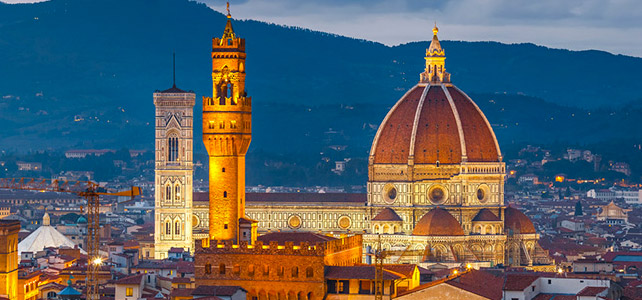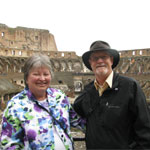 When you visit the city of Florence Italy, you’ll be struck by its impressive history. Once the great center of the Florence Renaissance, this is one of the world’s most artistic & architecturally beautiful cities, home to countless museums and galleries packed with great masterpieces, and with fabulous shopping and tremendous cuisine and restaurants.
When you visit the city of Florence Italy, you’ll be struck by its impressive history. Once the great center of the Florence Renaissance, this is one of the world’s most artistic & architecturally beautiful cities, home to countless museums and galleries packed with great masterpieces, and with fabulous shopping and tremendous cuisine and restaurants.Florence dates back to the Etruscan era, when Fiesole, an important center in Etruria, dominated the valley. The Romans conquered the city in 59 BC, then set up camp by the River Arno in a place that became known as Florentia, “destined to flower”. During the course of the next thousand years, a small population struggled under successive Byzantine, Goth, Lombard and Frankish rule.
The number of residents in Florence began to grow from the tenth century onward, with the city being ruled by an autonomous commune from 1115, but the city soon became a battleground in the violent conflict between the pro-imperial Ghibelline faction and the pro-papal Guelphs. Despite these conflicts, a strong merchant base, founded on wool and supported by a powerful currency (the florin) saw the city gradually grow.
By the 13th Century, a merchant elite ruled Florence. Powerful families such as the Albizi and then the Medici came to dominate the city. With this oligarchy interrupted by spates of republican rule – influenced by the likes of radical Dominican Pryor Savonarola and the nobleman Machiavelli – Florence grew ever stronger and richer.
It was during this period when Florence assumed its decisive role in European and world history. Experts in both banking and commerce (the Medici financed many of the adventures that opened up trade routes around the globe), the city grew spectacularly rich. The families who were at the top of this wealthy society flaunted their affluence, and money was poured into patronage of the fine arts. The city became home to sculptors, artists, architects and musicians. While scholars were rediscovering the fertile literature and archaic culture of Greece and Rome, Europe began to emerge from the Dark Ages; meanwhile the likes of Michelangelo, Donatello and Brunelleschi, as well as countless others whose works adorn the museums and galleries of Florence today, were pushing the bounds of creativity and artistic creation to ever-greater heights.
A literal explosion of intellectual power and creativity in the city saw a new crop of radical thinkers, and the spreading of their ideas through the new medium of printing. During this time, the Florentines’ ever-growing expertise in banking, accountancy, and the creation of credit saw the entire system become ever richer. Florence, it is often said, had become the cradle of all Europe.
Florence next became part of the Grand Duchy of Tuscany, but by the mid-1700’s the city had been consumed by Austria. In 1859 it was swallowed up by the kingdom of Sardinia-Piedmont, and only two years later Tuscany proper became part of the new country of Italy. For six years (until Rome joined the union) the city of Florence was actually the capital of Italy. 20th century Florence thrived on the back of tourism, financial services, heavy industry and its old staple – trade. Occupied by the Germans between 1943 and 1944, the city suffered the further misfortune of flooding in 1966, when the River Arno burst its banks.
Walking through the city’s narrow, windy streets, it is hard to identify Florence with just one symbol. It may be the sculpture of David by Michelangelo, or perhaps the romantic Ponte Vecchio, or Giotto’s bell tower. Then again, Florence is equally synonymous with famous people such as Leonardo Da Vinci, Michelangelo or Dante Alighieri, to name just a few.
Also, of course, there’s the world-famous “Duomo” which is perhaps the most recognizable of Florence’s monuments. Construction of the Gothic cathedral of Santa Maria del Fiore began in 1296 and was completed by Brunelleschi in 1436 with the famous Dome, which was painted inside with frescoes by Vasari and Zuccari. The square Bell tower designed by Giotto in 1334 stands on the right-hand side of the Florence Cathedral and is covered in white, green and red marble. The Baptistery of San Giovanni, one of the oldest monuments in Florence (1128), is located opposite the Cathedral and is built in the Florentine Romanesque style.
Today, even though most of Florence’s greatness lies in its enchanting history, the city still thrives. It has marvelous shopping, airy gardens & parks, fabulous cuisine, an exhilarating artistic atmosphere and breathtaking views of the surrounding countryside.
When you aren’t admiring the works of artists and sculptors in churches, galleries and museums such as the Uffizi and Accademia, you can wander around the luxury of world famous boutiques, watch craftsmen at work on traditional Florentine leatherwork, and peruse the numerous bustling street markets. You can eat in the finest restaurants or in simple trattorie with delicious home cooking. Or buy the ingredients for a quaint open-air picnic at the Mercato Centrale or Mercato di Sant’Ambrogio. Grab a bottle of Chianti, and make an excursion to the Boboli Gardens or to the ramparts of the Belvedere Fort with its stunning views.
Florence holds endless fascination for the thousands of travelers who visit Italy every day. There’s nothing in the world quite like it.





